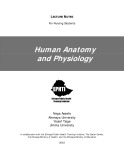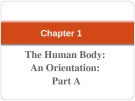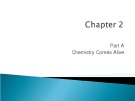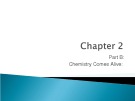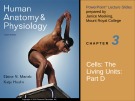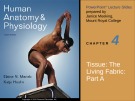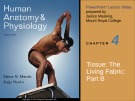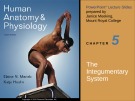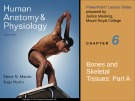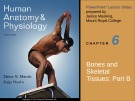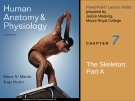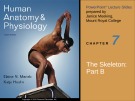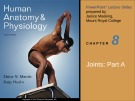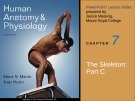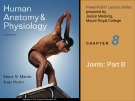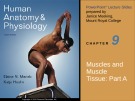
Human Anatomy and Physiology
-
Human anatomy and physiology is more than just interesting, it is fascinating. To help get the students and instructions involved in the study of this subject, a number of special features are incorporated throughout the lecture note.
 428p
428p  phannguyenhaminhths
phannguyenhaminhths
 18-08-2021
18-08-2021
 25
25
 2
2
 Download
Download
-
Chapter 1 - The human body: An orientation (part a). This chapter presents the following content: Overview of anatomy and physiology, principle of complementarity, levels of structural organization, overview of organ systems, organ systems interrelationships, necessary life functions,...and other contents.
 28p
28p  tangtuy07
tangtuy07
 02-04-2016
02-04-2016
 49
49
 4
4
 Download
Download
-
Lecture Human anatomy and physiology - Chapter 1: The human body: An orientation (part b). This part will be your lab assignment. Make sure you know your anatomical terminology, anatomical regions, body cavities, body positions and orientation.
 31p
31p  tangtuy07
tangtuy07
 02-04-2016
02-04-2016
 51
51
 2
2
 Download
Download
-
Why study chemistry in an anatomy and physiology course? The answer is simple. Your entire body is made up of chemicals, thousands of them, continuously interacting with one another at an incredible pace. Although it is possible to study anatomy without much reference to chemistry, chemical reactions underlie all physiological processes—movement, digestion, the pumping of your heart, and even your thoughts. This chapter presents the basic chemistry and biochemistry (the chemistry of living material) you need to understand body functions.
 62p
62p  tangtuy07
tangtuy07
 02-04-2016
02-04-2016
 52
52
 3
3
 Download
Download
-
Biochemistry is the study of the chemical composition and reactions of living matter. All chemicals in the body fall into one of two major classes: organic or inorganic compounds. Organic compounds contain carbon. All organic compounds are covalently bonded molecules, and many are large. All other chemicals in the body are considered inorganic compounds. These include water, salts, and many acids and bases. Organic and inorganic compounds are equally essential for life.
 51p
51p  tangtuy07
tangtuy07
 02-04-2016
02-04-2016
 41
41
 3
3
 Download
Download
-
Chapter 3 - Cells: The living units (part a). Just as bricks and timbers are the structural units of a house, cells are the structural units of all living things, from one-celled “generalists” like amoebas to complex multicellular organisms such as humans, dogs, and trees. The human body has 50 to 100 trillion of these tiny building blocks. This chapter focuses on structures and functions shared by all cells.
 36p
36p  tangtuy07
tangtuy07
 02-04-2016
02-04-2016
 65
65
 3
3
 Download
Download
-
Chapter 3 - Cells: The living units (part b). The main contents of this chapter include all of the following: Membrane transport: active processes, active transport, primary active transport, secondary active transport, vesicular transport, endocytosis and transcytosis,...and other contents.
 37p
37p  tangtuy07
tangtuy07
 02-04-2016
02-04-2016
 37
37
 3
3
 Download
Download
-
Chapter 3 (part c) provides knowledge of the cytoplasm. This chapter describe the composition of the cytosol; discuss the structure and function of mitochondria; discuss the structure and function of ribosomes, the endoplasmic reticulum, and the Golgi apparatus, including functional interrelationships among these organelles; compare the functions of lysosomes and peroxisomes.
 30p
30p  tangtuy07
tangtuy07
 02-04-2016
02-04-2016
 49
49
 2
2
 Download
Download
-
This chapter provides knowledge of cell cycle. The main contents of this chapter include all of the following: List the phases of the cell cycle and describe the key events of each phase, describe the process of DNA replication.
 9p
9p  tangtuy07
tangtuy07
 02-04-2016
02-04-2016
 32
32
 1
1
 Download
Download
-
This chapter list the steps involved in preparing animal tissue for microscopic viewing; list several structural and functional characteristics of epithelial tissue; name, classify, and describe the various types of epithelia, and indicate their chief function(s) and location(s).
 29p
29p  tangtuy07
tangtuy07
 02-04-2016
02-04-2016
 45
45
 3
3
 Download
Download
-
Connective tissue is the most abundant and widely distributed of the primary tissues, but its amount in particular organs varies. For example, skin consists primarily of connective tissue, while the brain contains very little. This chapter provides knowledge of connective tissue, indicate common characteristics of connective tissue, and list and describe its structural elements.
 48p
48p  tangtuy07
tangtuy07
 02-04-2016
02-04-2016
 40
40
 2
2
 Download
Download
-
Would you be enticed by an ad for a coat that is waterproof, stretchable, washable, and permanent-press, that automatically repairs small cuts, rips, and burns? How about one that’s guaranteed to last a lifetime? Sounds too good to be true, but you already have such a coat-your skin. The skin and its derivatives (sweat and oil glands, hairs, and nails) make up a complex set of organs that serves several functions, mostly protective. Together, these organs form the integumentary system.
 67p
67p  tangtuy07
tangtuy07
 02-04-2016
02-04-2016
 51
51
 2
2
 Download
Download
-
Lecture Human anatomy and physiology - Chapter 6: Bones and skeletal tissues (part a). When you finish this chapter, you should: Describe the functional properties of the three types of cartilage tissue, locate the major cartilages of the adult skeleton, explain how cartilage grows, name the major regions of the skeleton and describe their relative functions, compare and contrast the four bone classes and provide examples of each class,...
 41p
41p  tangtuy07
tangtuy07
 02-04-2016
02-04-2016
 46
46
 3
3
 Download
Download
-
Chapter 6: Bones and skeletal tissues (part b) provides knowledge of bone development, bone homeostasis, homeostatic imbalances of bone and developmental aspects of bones. After completing this chapter, students will be able to: Compare and contrast intramembranous ossification and endochondral ossification, describe the process of long bone growth that occurs at the epiphyseal plates,...and other contents.
 53p
53p  tangtuy07
tangtuy07
 02-04-2016
02-04-2016
 37
37
 3
3
 Download
Download
-
Chapter 7 - The skeleton (part a) provides knowledge of the skull. After completing this unit, you should be able to: Name, describe, and identify the skull bones. Identify their important markings; compare and contrast the major functions of the cranium and the facial skeleton.
 52p
52p  tangtuy07
tangtuy07
 02-04-2016
02-04-2016
 56
56
 3
3
 Download
Download
-
Chapter 7 - The skeleton (part b) provides knowledge of vertebral column and thoracic cage. This chapter describe the structure of the vertebral column, list its components, and describe its curvatures; indicate a common function of the spinal curvatures and the intervertebral discs; name and describe the bones of the thoracic cage (bony thorax); differentiate true from false ribs.
 35p
35p  tangtuy07
tangtuy07
 02-04-2016
02-04-2016
 39
39
 3
3
 Download
Download
-
Chapter 8 part a provides knowledge of classification of joints, fibrous joints and cartilaginous joints. After studying this chapter you will be able to: Define joint or articulation, classify joints by structure and by function, describe the general structure of fibrous joints, name and give an example of each of the three common types of fibrous joints, describe the general structure of cartilaginous joints, name and give an example of each of the two common types of cartilaginous joints.
 59p
59p  tangtuy07
tangtuy07
 02-04-2016
02-04-2016
 38
38
 3
3
 Download
Download
-
Bones of the limbs and their girdles are collectively called the appendicular skeleton because they are appended to the axial skeleton that forms the longitudinal axis of the body. Chapter 7 - The skeleton (part c) provides knowledge of appendicular skeleton.
 50p
50p  tangtuy07
tangtuy07
 02-04-2016
02-04-2016
 33
33
 2
2
 Download
Download
-
Chapter 8 - Joints (part b) provides knowledge of synovial joints, homeostatic imbalances of joints and developmental aspects of joints. After completing this unit, you should be able to: Describe the structural characteristics of synovial joints, compare the structures and functions of bursae and tendon sheaths, list three natural factors that stabilize synovial joints, name the most common joint injuries and discuss the symptoms and problems associated with each,...and other contents.
 59p
59p  tangtuy07
tangtuy07
 02-04-2016
02-04-2016
 51
51
 7
7
 Download
Download
-
Chapter 9 - Muscles and muscle tissue (part a) provides knowledge of muscle tissues and skeletal muscle. The following will be discussed in this chapter: Types of muscle tissue, special characteristics of muscle tissue, muscle functions, gross anatomy of a skeletal muscle, microscopic anatomy of a skeletal muscle fiber, sliding filament model of contraction, physiology of skeletal muscle fibers,...
 65p
65p  tangtuy07
tangtuy07
 02-04-2016
02-04-2016
 59
59
 3
3
 Download
Download
CHỦ ĐỀ BẠN MUỐN TÌM








